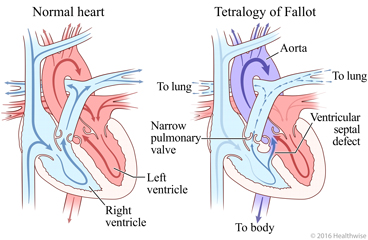
What is tetralogy of Fallot?
Tetralogy of Fallot (say "fuh-LOH") is a type of congenital heart disease. Congenital heart disease refers to heart problems a baby is born with. These heart problems are usually diagnosed at or before birth.
Fallot is the name of a doctor who found this problem. A "tetralogy" is a group of four related things. So this heart problem is actually a set of four different problems in the baby's heart.
The heart has two main jobs: send oxygen-rich blood (red blood) from the lungs out to the body, and bring oxygen-poor blood (blue blood) from the body back to the lungs. The four problems in tetralogy of Fallot keep the heart from doing these jobs well. The problems include:
- Ventricular septal defect (VSD). This is an opening, or hole, between the two lower chambers of the heart, the ventricles. The hole lets red blood and blue blood mix before the blood flows to the body.
- Overriding aorta. The large blood vessel called the aorta normally carries red blood from the left ventricle out to the body. An overriding aorta is attached to the heart in the wrong place. Instead of sitting on top of the ventricle, it sits on top of the ventricular septal defect. So instead of getting red blood, it gets a mixture of red and blue blood.
- Pulmonary stenosis. The heart sends blue blood to the lungs through the pulmonary valve. "Stenosis" means the valve—and sometimes the pulmonary artery—are too narrow. Less blood flows to the lungs to pick up oxygen.
- Thickened right lower chamber of the heart. Because of pulmonary stenosis, the right ventricle has to work harder to pump enough blood to the lungs. This makes the ventricle wall thicker and leaves less room for pumping blood.
These heart problems keep your baby's body from getting enough oxygen.
How is tetralogy of Fallot diagnosed?
Your doctor may hear abnormal heart sounds, such as a heart murmur, when examining your newborn.
Your doctor will order tests to find the cause of abnormal sounds or of symptoms. The most common test used to identify this problem is called an echocardiogram, or "echo" for short. It uses sound waves to make an image of your baby's heart.
Your baby may have other tests, such as an ECG or EKG (electrocardiogram), chest X-ray, and checking the amount of oxygen in the blood.
A fetal ultrasound, which lets your doctor see an image of your baby before birth, sometimes finds this problem.
What are the symptoms?
Symptoms of tetralogy of Fallot may include:
- A blue tint to the skin, lips, or fingernails.
- Fast breathing.
- Sweating while feeding.
- Not eating well.
- Being fussy a lot of the time.
How is tetralogy of Fallot treated?
Your doctor will help you understand your baby's condition, your treatment choices, and what to expect from each choice.
Your baby may get medicine that helps keep red blood flowing to the body. The medicine may be given through a blood vessel in the belly button.
Your baby will need open-heart surgery to repair the problems.
What can you expect?
- You may see tubes and wires attached to your baby. This can be scary to see. But these things help the doctor treat your baby. The tubes supply air, fluid, and medicines to your baby. The wires are attached to machines that help the doctor keep track of your baby's vital signs. These include temperature, blood pressure, breathing rate, and pulse rate.
- If your baby has trouble breathing, the doctor may use a ventilator. This machine helps your baby breathe. To use the machine, the doctor puts a soft tube through your baby's mouth into the windpipe.
- The hospital staff will give your baby the nutrition that your baby needs. The doctor may feed your baby through a soft tube that goes through the nose and into the stomach. Or the doctor may use an I.V. that goes through the belly button to do this.
- Your baby may need oxygen. It is given to the baby through a tube in the nose or throat.
- Your baby will be kept comfortable and warm.
- It may seem that your baby is getting lots of tests. All of these tests help your doctor keep track of your baby's condition and give the best treatment possible.
- After surgery, your baby will need routine checkups to check the heart
- It's hard to be apart from your baby, especially when you worry about your baby's condition. Know that the hospital staff is well prepared to care for babies with this condition. They will do everything they can to help. If you need it, ask for support from friends and family. You can also ask the hospital staff about counselling and support.
Follow-up care is a key part of your child's treatment and safety. Be sure to make and go to all appointments, and call your doctor or nurse advice line (811 in most provinces and territories) if your child is having problems. It's also a good idea to know your child's test results and keep a list of the medicines your child takes.
Where can you learn more?
Go to https://www.healthwise.net/patientEd
Enter Q619 in the search box to learn more about "Learning About Tetralogy of Fallot in Newborns".
